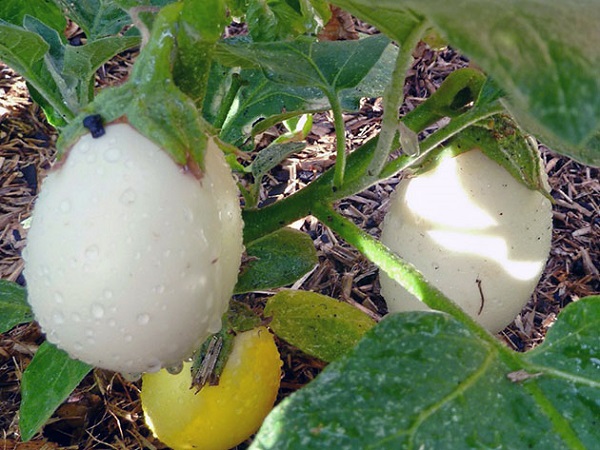Features of growing white eggplant
Content
Description
White eggplants are nothing more than hybrids bred by breeders from ordinary purple eggplants in order to improve the taste. The fact is that blue vegetables contain special pigment substances anthocyanins - these are plant glycosides that give plants an intense dark color and a characteristic bitter taste.
In the process of hybridization, biologists simply isolated this pigment and got a variety that differs from the base one in the absence of bitterness and dark color. It will be fair to say that anthocyanins are very beneficial for human health - they are a strong antioxidant, protect the body from free radicals and remove radionuclides. Therefore, although white eggplants are tastier, they are inferior in properties to purple vegetables.
When choosing a white variety of eggplant for a garden or greenhouse, you should give preference to early and mid-season vegetables that are capable of producing a good harvest, despite the difficult climatic conditions. Of course, white eggplants are not as diverse as blue ones, but there are still plenty to choose from:
Ping pong. This variety is a favorite among white vegetables. The original small (5-7 cm in length and weighing 80-90 g) spherical fruits have dense pulp without bitterness, are well transported and stored. Early maturing culture - technical maturity is reached 115-117 days after sowing.
Iceberg. Fruits are elongated (15-20 cm), widened towards the bottom, with white, dense, not bitter pulp, reaching a mass of 150-250 g. The variety is mid-season (115-125 days), resistant to temperature fluctuations and diseases.
Swan. Early maturing eggplant (98-115 days), suitable for growing in soil. Fruits are cylindrical, long (18-25 cm), large (180-300 g). The peel of the fruit is yellowish, the flesh is white, very tender. Transportable, high-yielding, can lie for a long time.
Icicle. An early ripe variety with thin and long, really icicle-like fruits 20-30 cm long. The pulp is dense, creamy, without bitterness. Suitable for greenhouse and garden cultivation.
Pelican. An early ripe hybrid recommended for greenhouses. Fruits are long (16-20 cm), cylindrical, 4-5 cm in diameter. The pulp is slightly creamy, firm. Eggplants are well transported and have an attractive presentation.
Snowy. An early ripe variety (100-106 days) for growing under cover. Fruits are long (18-20 cm), slightly curved, with a glossy surface, weighing 280-350 g. The peel is thin and tender, the flesh is white, dense. Sufficiently productive - from 1 sq. m you can collect 4.5-5.8 kg.
White Night. An early ripening hybrid (100-112 days), suitable for growing in the garden. Hardy enough, can set fruits at low temperatures. Fruits are cylindrical, wide, weighing 200-250 g. The pulp is white-creamy, dense. Productivity - 5.5-6 kg per 1 sq. m.
Ovoid. An original mid-season variety for warm climates. Fruits are small (30-40 g), ovoid, with a white glossy surface. Suitable for whole stuffing and canning.
Of course, these are not all white eggplants.There are several more varieties with an unusual taste: champignons, chicken meat, nuts. Several intermediate hybrids of green or light purple color have also been bred, however, they taste the same as ordinary white vegetables.
Eggplant Care Video
This video shows you how to grow and care for eggplants to get a good harvest.
Features of agricultural technology
All eggplants are grown through seedlings, since they differ in a rather long growing season - 3 months pass from sowing seeds to the ripening of early fruits, and the late variety ripens only after 120 days. Therefore, you need to plant seedlings in early spring (end of February). Already grown plants, which are at least two months old, are planted in open ground.
Growing white eggplants is no more difficult than growing blue ones. However, it must be remembered that they are more thermophilic. If a temperature of 17-20 ° C is required for seedlings of ordinary eggplants, then for white vegetables it should be at least 25 ° C. Many vegetable growers in the process of growing resort to growth stimulants, since it is not so easy to grow seedlings in a pot for up to 2 months.
White eggplants do not tolerate transplanting well, for this reason, it is better to plant seeds immediately in separate cups, so that later they can be transferred to the ground together with the ground. In extreme cases, if the eggplants were sown in a large box, young shoots should be dived at the stage of 2-3 true leaves, and then grown in a separate container.
Any white eggplant variety needs feeding. They need to be applied even during the growth of seedlings - this will strengthen the root system and the plants themselves. Eggplants love mineral mixtures containing organic components, such as humus. To improve growth, formation of ovaries and increase plant resistance to diseases, foliar dressing is recommended with special preparations such as "Bud", "Ovary", as well as organic matter (ash).
White vegetables, like blue ones, are very demanding on moisture. Regular watering is the key to abundant flowering, and, accordingly, a bountiful harvest. After planting in the ground, eggplants are watered 1 time / 2-3 days. In case of abnormal heat, it is necessary to monitor the state of soil moisture - you may have to water it daily. Timely watering during the flowering period of plants is especially important, since in its absence, the flower stalks will fall off, which will lead to loss of yield.
Adult plants growing in the garden, like all nightshades, are very responsive to feeding. Simultaneously with watering, organic solutions can be applied at the root: droppings, mullein, ash with a frequency of 1 time / week. If eggplants grow poorly (this is possible on sandy and clay soils), then you cannot do without a mineral fertilizer containing phosphorus and potassium. However, here you need to be careful - you can use mineral mixtures no later than three weeks before harvesting.
Video "Peculiarities of eggplant care"
All the intricacies of growing eggplant are described in this video.







